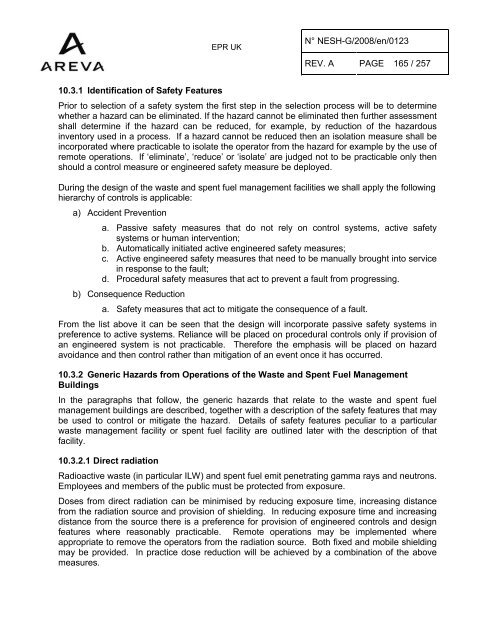Solid Radioactive Waste Strategy Report.pdf - UK EPR
Solid Radioactive Waste Strategy Report.pdf - UK EPR
Solid Radioactive Waste Strategy Report.pdf - UK EPR
Create successful ePaper yourself
Turn your PDF publications into a flip-book with our unique Google optimized e-Paper software.
<strong>EPR</strong> <strong>UK</strong><br />
N° NESH-G/2008/en/0123<br />
REV. A PAGE 165 / 257<br />
10.3.1 Identification of Safety Features<br />
Prior to selection of a safety system the first step in the selection process will be to determine<br />
whether a hazard can be eliminated. If the hazard cannot be eliminated then further assessment<br />
shall determine if the hazard can be reduced, for example, by reduction of the hazardous<br />
inventory used in a process. If a hazard cannot be reduced then an isolation measure shall be<br />
incorporated where practicable to isolate the operator from the hazard for example by the use of<br />
remote operations. If ‘eliminate’, ‘reduce’ or ‘isolate’ are judged not to be practicable only then<br />
should a control measure or engineered safety measure be deployed.<br />
During the design of the waste and spent fuel management facilities we shall apply the following<br />
hierarchy of controls is applicable:<br />
a) Accident Prevention<br />
a. Passive safety measures that do not rely on control systems, active safety<br />
systems or human intervention;<br />
b. Automatically initiated active engineered safety measures;<br />
c. Active engineered safety measures that need to be manually brought into service<br />
in response to the fault;<br />
d. Procedural safety measures that act to prevent a fault from progressing.<br />
b) Consequence Reduction<br />
a. Safety measures that act to mitigate the consequence of a fault.<br />
From the list above it can be seen that the design will incorporate passive safety systems in<br />
preference to active systems. Reliance will be placed on procedural controls only if provision of<br />
an engineered system is not practicable. Therefore the emphasis will be placed on hazard<br />
avoidance and then control rather than mitigation of an event once it has occurred.<br />
10.3.2 Generic Hazards from Operations of the <strong>Waste</strong> and Spent Fuel Management<br />
Buildings<br />
In the paragraphs that follow, the generic hazards that relate to the waste and spent fuel<br />
management buildings are described, together with a description of the safety features that may<br />
be used to control or mitigate the hazard. Details of safety features peculiar to a particular<br />
waste management facility or spent fuel facility are outlined later with the description of that<br />
facility.<br />
10.3.2.1 Direct radiation<br />
<strong>Radioactive</strong> waste (in particular ILW) and spent fuel emit penetrating gamma rays and neutrons.<br />
Employees and members of the public must be protected from exposure.<br />
Doses from direct radiation can be minimised by reducing exposure time, increasing distance<br />
from the radiation source and provision of shielding. In reducing exposure time and increasing<br />
distance from the source there is a preference for provision of engineered controls and design<br />
features where reasonably practicable. Remote operations may be implemented where<br />
appropriate to remove the operators from the radiation source. Both fixed and mobile shielding<br />
may be provided. In practice dose reduction will be achieved by a combination of the above<br />
measures.

















